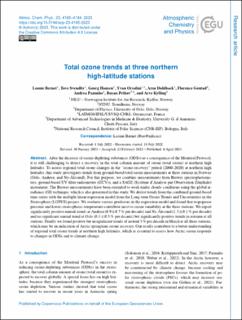| dc.contributor.author | Bernet, Leonie | |
| dc.contributor.author | Svendby, Tove Marit | |
| dc.contributor.author | Hansen, Georg Heinrich | |
| dc.contributor.author | Orsolini, Yvan | |
| dc.contributor.author | Dahlback, Arne | |
| dc.contributor.author | Goutail, Florence | |
| dc.contributor.author | Pazmino, Andrea | |
| dc.contributor.author | Petkov, Boyan | |
| dc.contributor.author | Kylling, Arve | |
| dc.date.accessioned | 2023-04-12T10:45:14Z | |
| dc.date.available | 2023-04-12T10:45:14Z | |
| dc.date.created | 2023-04-11T12:49:29Z | |
| dc.date.issued | 2023 | |
| dc.identifier.citation | Atmospheric Chemistry and Physics (ACP). 2023, 23, 4165-4184. | en_US |
| dc.identifier.issn | 1680-7316 | |
| dc.identifier.uri | https://hdl.handle.net/11250/3062606 | |
| dc.description.abstract | After the decrease of ozone-depleting substances (ODSs) as a consequence of the Montreal Protocol, it is still challenging to detect a recovery in the total column amount of ozone (total ozone) at northern high latitudes. To assess regional total ozone changes in the “ozone-recovery” period (2000–2020) at northern high latitudes, this study investigates trends from ground-based total ozone measurements at three stations in Norway (Oslo, Andøya, and Ny-Ålesund). For this purpose, we combine measurements from Brewer spectrophotometers, ground-based UV filter radiometers (GUVs), and a SAOZ (Système d'Analyse par Observation Zénithale) instrument. The Brewer measurements have been extended to work under cloudy conditions using the global irradiance (GI) technique, which is also presented in this study. We derive trends from the combined ground-based time series with the multiple linear regression model from the Long-term Ozone Trends and Uncertainties in the Stratosphere (LOTUS) project. We evaluate various predictors in the regression model and found that tropopause pressure and lower-stratospheric temperature contribute most to ozone variability at the three stations. We report significantly positive annual trends at Andøya (0.9±0.7 % per decade) and Ny-Ålesund (1.5±0.1 % per decade) and no significant annual trend at Oslo (0.1±0.5 % per decade) but significantly positive trends in autumn at all stations. Finally we found positive but insignificant trends of around 3 % per decade in March at all three stations, which may be an indication of Arctic springtime ozone recovery. Our results contribute to a better understanding of regional total ozone trends at northern high latitudes, which is essential to assess how Arctic ozone responds to changes in ODSs and to climate change. | en_US |
| dc.language.iso | eng | en_US |
| dc.rights | Navngivelse 4.0 Internasjonal | * |
| dc.rights.uri | http://creativecommons.org/licenses/by/4.0/deed.no | * |
| dc.title | Total ozone trends at three northern high-latitude stations | en_US |
| dc.title.alternative | Total ozone trends at three northern high-latitude stations | en_US |
| dc.type | Peer reviewed | en_US |
| dc.type | Journal article | en_US |
| dc.description.version | publishedVersion | en_US |
| dc.rights.holder | © Author(s) 2023. | en_US |
| dc.source.pagenumber | 4165-4184 | en_US |
| dc.source.volume | 23 | en_US |
| dc.source.journal | Atmospheric Chemistry and Physics (ACP) | en_US |
| dc.identifier.doi | 10.5194/acp-23-4165-2023 | |
| dc.identifier.cristin | 2139952 | |
| dc.relation.project | NILU: 121002 | en_US |
| cristin.ispublished | true | |
| cristin.fulltext | original | |
| cristin.qualitycode | 2 | |

